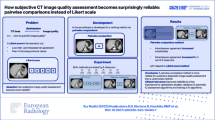Abstract
The purpose of this study was to develop and test a method to delineate lung field boundaries in dual-energy chest x-ray images. The segmenting method uses soft-tissue images and spatial frequency–dependent, background-subtracted images. Large-scale chest anatomy features are located and used to select the lung apices, the lateral lung boundaries, and the lung–mediastinum and lung–diaphragm boundaries. Extraneous parts of the contours are removed and they are joined to form complete lung boundaries. The reliability measure uses a statistical shape model to estimate the probability of occurrence of a contour. The method was experimentally tested with 30 human subject images. It has higher accuracy and specificity and a sensitivity parameter equal to the best previously reported method. The reliability measure is able to detect contours with unusual lung outlines or errors in the processing. The method exploits the characteristics of dual-energy subtraction images to improve lung field segmenting performance.












Similar content being viewed by others
References
N Nakamori K Doi V Sabeti et al. (1990) ArticleTitleImage feature analysis and computer-aided diagnosis in digital radiography: automated analysis of sizes of heart and lung in chest images. Med Phys 17 342–350 Occurrence Handle10.1118/1.596513 Occurrence Handle1:STN:280:By%2BA2cfltFE%3D Occurrence Handle2143554
S Sanada K Doi H MacMahon (1992) ArticleTitleImage feature analysis and computer-aided diagnosis in digital radiography: automated detection of pneumothorax in chest images. Med Phys 19 1153–1160 Occurrence Handle10.1118/1.596790 Occurrence Handle1:STN:280:ByyD283ltVc%3D Occurrence Handle1435592
B Ginneken Particlevan BMtH Romeny MA Viergever (2001) ArticleTitleComputer-aided diagnosis in chest radiography: a survey. IEEE TransMed Imaging 20 1228–1241 Occurrence Handle10.1109/42.974918
LA Lehmann RE Alvarez A Macovski WR Brody NJ Pelc SJ Riederer AL Hall (1981) ArticleTitleGeneralized image combinations in dual KVP digital radiography. Med Phys 8 659–667 Occurrence Handle10.1118/1.595025 Occurrence Handle1:STN:280:Bi2D3srks1Y%3D Occurrence Handle7290019
RE Alvarez A Macovski (1976) ArticleTitleEnergy-selective reconstructions in X-ray computerized tomography. Phys Med Biol 21 733–744 Occurrence Handle10.1088/0031-9155/21/5/002 Occurrence Handle1:STN:280:CSiD3MznsVA%3D Occurrence Handle967922
X-W Xu H MacMahon K Doi (1999) Detection of lung nodule on digital energy subtracted soft-tissue and conventional chest images from a Cr system. K Doi H MacMahon M.L. Giger K.R. Hoffmann (Eds) In Computer Aided Diagnosis in Medical Imaging Elsevier Science B.V. Amsterdam, The Netherlands 63–69
J Duryea JM Boone (1995) ArticleTitleA fully automated algorithm for the segmentation of lung fields on digital chest radiographic images. Med Phys 22 183–191 Occurrence Handle10.1118/1.597539 Occurrence Handle1:STN:280:BymD3Mrmt1U%3D Occurrence Handle7565349
NF Vittitoe R Vargas-Voracek CF Floyd SuffixJr (1998) ArticleTitleIdentification of lung regions in chest radiographs using Markov random field modeling. Med Phys 25 976–985 Occurrence Handle10.1118/1.598405 Occurrence Handle1:STN:280:DyaK1czhtlyktg%3D%3D Occurrence Handle9650188
B Ginneken Particlevan BM terHaar Romeny (2000) ArticleTitleAutomatic segmentation of lung fields in chest radiographs. Med Phys 27 2445–2455 Occurrence Handle10.1118/1.1312192 Occurrence Handle11099215
TF Cootes CJ Taylor DH Cooper J Graham (1995) ArticleTitleActive shape models—their training and application. Computer Vision and Image Understanding 61 38–59 Occurrence Handle10.1006/cviu.1995.1004
B Ginneken (2001) Computer-Aided Diagnosis in Chest Radiography. Image Sciences Institute, University Medical Center Utrecht The Netherlands
MS Brown LS Wilson Doust B.D. Gill R.W. C Sun (1998) ArticleTitleKnowledge based method for segmentation and analysis of lung boundaries in chest x-ray images. Comput Med Imag Graphics 22 463–477 Occurrence Handle10.1109/42.974918
B Ginneken Particlevan AF Frangi JJ Staal BMtH Romeny MA Viergever (2002) ArticleTitleActive shape model segmentation with optimal features. IEEE Trans Med Imaging 21 .–.
HG Chotas CE Ravin (1994) ArticleTitleChest radiography: estimated lung volume and projected area obscured by the heart, mediastinum, and diaphragm. Radiology 193 403–440 Occurrence Handle1:STN:280:ByqD283pslw%3D Occurrence Handle7972752
DM Wuescher KL Boyer (1991) ArticleTitleRobust contour decomposition using constant curvature criterion. IEEE Tr Pattern Analysis Mach Intell 13 41–51 Occurrence Handle10.1109/34.67629
JE Jackson (1991) A User’s Guide to Principal Components. John Wiley and Sons New York
JE Jackson GS Mudholkar (1979) ArticleTitleControl procedures for residuals associated with principal component Analysis. Technometrics 21 341–349 Occurrence Handle1:CAS:528:DyaK3MXhtF2gsbg%3D Occurrence Handle1988937
RE Alvarez JA Seibert TF Poage (1997) ArticleTitleActive dual-energy x-ray detector: experimental characterization. Proc SPIE 3032 419–426
WL Martinez AR Martinez (2001) Computational Statistics Handbook with MATLAB, Chapter 7. CRC Press Boca Raton FL
SG Armato ML Giger H MacMahon (1999) Automated abnormal asymmetry detection in digital posteroanterior chest radiographs. K. Doi H. MacMahon M.L. Giger K.R. Hoffmann (Eds) Computer-Aided Diagnosis in Medical Imaging. Elsevier Science B.V. Amsterdam, the Netherlands 89–93
Acknowledgments
I acknowledge the assistance of Dr. Elizabeth H. Moore, Dr. J. Anthony Seibert of the University of California, Davis Medical Center, and Dr. Reginald Munden and Mr. Stephen K. Thompson of the University of Texas, M.D. Anderson Cancer Center in providing the human subject image data. I also acknowledge the assistance of Dr. Linda S. Maltz on statistical questions. This work was supported in part by National Institutes of Health SBIR grant R3CA97826A. Its contents are solely the responsibility of the author and do not necessarily represent the official views of the National Institutes of Health.
Author information
Authors and Affiliations
Corresponding author
Rights and permissions
About this article
Cite this article
Alvarez, R.E. Lung Field Segmenting in Dual-Energy Subtraction Chest X-ray Images. J Digit Imaging 17, 45–56 (2004). https://doi.org/10.1007/s10278-003-1701-8
Published:
Issue Date:
DOI: https://doi.org/10.1007/s10278-003-1701-8




